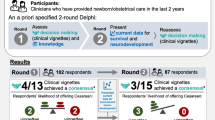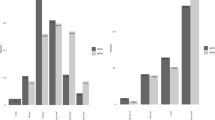Abstract
Objective
To qualitatively evaluate women’s perspectives on shared decision-making for periviable (22–25 weeks’ gestational age) mode of delivery (MOD).
Study Design
Interviews were conducted at two Midwestern academic hospitals with 30 women hospitalized for threatened periviable delivery between September 2016 and January 2018. Prior to delivery (T1) and at 3-months postpartum (T2), MOD-related decision-making was explored using prompts. Interviews were coded and analyzed using NVivo 12.
Result
The majority of women perceived the MOD options as cesarean section or vaginal delivery. Most ultimately preferred “whatever’s best for baby.” Understanding of MOD risks was limited, and physicians recommended each option equally. Sixteen participants perceived themselves as decision-makers at T1, while at T2, only nine participants identified themselves as such.
Conclusion
Informed deference is introduced as a novel concept in the setting of periviable MOD decision-making, whereby the mother defers decisional authority to the provider, the baby, a higher power, or the circumstance itself.
This is a preview of subscription content, access via your institution
Access options
Subscribe to this journal
Receive 12 print issues and online access
$259.00 per year
only $21.58 per issue
Buy this article
- Purchase on Springer Link
- Instant access to full article PDF
Prices may be subject to local taxes which are calculated during checkout
Similar content being viewed by others
Data availability
The dataset generated and analyzed in the current study is available from the corresponding author on reasonable request.
References
American College of Obstetricians and Gynecologists. Periviable birth. Obstetric Care Consensus No. 6. Obstet Gynecol. 2017;130:187–99.
Bell EF, Hintz SR, Hansen NI, Bann CM, Wyckoff MH, DeMauro SB, et al. Mortality, in-hospital morbidity, care practices, and 2-year outcomes for extremely preterm infants in the US, 2013-2018. JAMA 2022;327:248–63.
Haward MF, John LK, Lorenz JM, Fischhoff B. Effects of description of options on parental perinatal decision-making. Pediatrics 2012;129:891–902.
Guillén Ú, Mackley A, Laventhal N, Kukora S, Christ L, Derrick M, et al. Evaluating the use of a decision aid for parents facing extremely premature delivery: a randomized trial. J Pediatr. 2019;209:52–60.e1
Martinez AM, Weiss E, Partridge JC, Freeman H, Kilpatrick S. Management of extremely low birth weight infants: perceptions of viability and parental counseling practices. Obstet Gynecol. 1998;92:520–4.
Geurtzen R, van Heijst AFJ, Draaisma JMT, Kuijpers LJMK, Woiski M, Scheepers HCJ, et al. Development of nationwide recommendations to support prenatal counseling in extreme prematurity. Pediatrics 2019;143:e20183253.
Srinivas SK. Periviable births: communication and counseling before delivery. Semin Perinatol. 2013;37:426–30.
Mercer BM. Mode of delivery for periviable birth. Semin Perinatol. 2013;37:417–21.
Raju TNK, Mercer BM, Burchfield DJ, Joseph GF. Periviable birth: executive summary of a Joint Workshop by the Eunice Kennedy Shriver National Institute of Child Health and Human Development, Society for Maternal-Fetal Medicine, American Academy of Pediatrics, and American College of Obstetricians and Gynecologists. J Perinatol J Calif Perinat Assoc. 2014;34:333–42.
Gluck O, Tairy D, Bar J, Barda G. The impact of mode of delivery on neonatal outcome in preterm births. J Matern-Fetal Neonatal Med J Eur Assoc Perinat Med Fed Asia Ocean Perinat Soc Int Soc Perinat Obstet. 2021;34:1183–9.
Liu S, Liston RM, Joseph KS, Heaman M, Sauve R, Kramer MS, et al. Maternal mortality and severe morbidity associated with low-risk planned cesarean delivery versus planned vaginal delivery at term. CMAJ Can Med Assoc J J Assoc Med Can. 2007;176:455–60.
Rm S, Mb L, Dj R, Kj L, Cy S, Ea T. Cesarean Deliv Matern Req. 2019;133:5.
Arzuaga BH, Cummings CL. Deliveries at extreme prematurity: outcomes, approaches, institutional variation, and uncertainty. Curr Opin Pediatr. 2019;31:182–7.
Kawakita T, Sondheimer T, Jelin A, Reddy UM, Landy HJ, Huang CC, et al. Maternal morbidity by attempted route of delivery in periviable birth. J Matern-Fetal Neonatal Med J Eur Assoc Perinat Med Fed Asia Ocean Perinat Soc Int Soc Perinat Obstet. 2021;34:1241–8.
Clements KM, Barfield WD, Ayadi MF, Wilber N. Preterm birth–associated cost of early intervention services: an analysis by gestational age. Pediatrics 2007;119:e866–74.
Halperin ME, Moore DC, Hannah WJ. Classical versus low-segment transverse incision for preterm caesarean section: maternal complications and outcome of subsequent pregnancies. Br J Obstet Gynaecol. 1988;95:990–6.
Armstrong C. ACOG Updates Recommendations on Vaginal Birth After Previous Cesarean Delivery. 3.
Barry MJ, Edgman-Levitan S. Shared decision making–pinnacle of patient-centered care. N Engl J Med. 2012;366:780–1.
Levenstein J. The Patient-centred general practice consultation. 2012;
Makoul G, Clayman ML. An integrative model of shared decision making in medical encounters. Patient Educ Couns. 2006;60:301–12.
Elwyn G, Frosch D, Thomson R, Joseph-Williams N, Lloyd A, Kinnersley P, et al. Shared decision making: a model for clinical practice. J Gen Intern Med. 2012;27:1361–7.
Begley K, Daly D, Panda S, Begley C. Shared decision-making in maternity care: Acknowledging and overcoming epistemic defeaters. J Eval Clin Pr. 2019;25:1113–20.
Tucker Edmonds B, Laitano T, Hoffman SM, Jeffries E, Fadel W, Bhamidipalli SS, et al. The impact of decision quality on mental health following periviable delivery. J Perinatol J Calif Perinat Assoc. 2019;39:1595–601.
Jager S, Kavanaugh K, Hoffman S, Laitano T, Jeffries E, Tucker Edmonds B. Parents’ descriptions of neonatal palliation as a treatment option prior to periviable delivery. J Perinat Neonatal Nurs. 2020;34:178–85.
Dyar KL. Qualitative inquiry in nursing: Creating rigor. Nurs Forum (Auckl). 2022;57:187–200.
Guest G, MacQueen KM, Namey EE, (Eds.). Applied thematic analysis. In Thousand Oaks, California: SAGE Publications, Inc; 2012.
Frosch DL, Kaplan RM. Shared decision making in clinical medicine: past research and future directions. Am J Prev Med. 1999;17:285–94.
Charles C, Gafni A, Whelan T. Shared decision-making in the medical encounter: what does it mean? (or it takes at least two to tango). Soc Sci Med 1982. 1997;44:681–92.
Grobman WA, Kavanaugh K, Moro T, DeRegnier RA, Savage T. Providing advice to parents for women at acutely high risk of periviable delivery. Obstet Gynecol. 2010;115:904–9.
Attanasio LB, Kozhimannil KB, Kjerulff KH. Factors influencing women’s perceptions of shared decision making during labor and delivery: Results from a large-scale cohort study of first childbirth. Patient Educ Couns. 2018;101:1130–6.
Lavrakas P. Encyclopedia of Survey Research Methods. 2022 Jun; Available from: https://methods.sagepub.com/reference/encyclopedia-of-survey-research-methods.
Kramer M, Hogue C. What causes racial disparities in very preterm birth? A biosocial perspective. Epidemiol Rev. 2009
MacDorman MF, Kirmeyer S. Fetal and perinatal mortality, United States, 2005. Natl Vital- Stat Rep. Cent Dis Control Prev Natl Cent Health Stat Natl Vital- Stat Syst. 2009;57:1–19.
Martin JA, Hamilton BE, Osterman MJ, Curtin SC, Matthews TJ. Births: final data for 2013. Natl Vital- Stat Rep. Cent Dis Control Prev Natl Cent Health Stat Natl Vital- Stat Syst. 2015;64:1–65.
Martin JA, Hamilton BE, Osterman M. Births in the United States, 2020. NCHS Data Brief. 2021;(418):1-8.
Funding
This study was funded by the NIH as a R21 Exploratory/Developmental Research Grant (HD089032-01).
Author information
Authors and Affiliations
Contributions
BTE and KK contributed to the study concept, design, analysis, and writing of this manuscript. KK served as an advisor to BTE. SMJ, LMB, SMH, and TL contributed to the recruitment, data management, analysis, and writing of the manuscript. JP contributed to analysis and writing.
Corresponding author
Ethics declarations
Competing interests
The authors declare no competing interests.
Additional information
Publisher’s note Springer Nature remains neutral with regard to jurisdictional claims in published maps and institutional affiliations.
Rights and permissions
Springer Nature or its licensor (e.g. a society or other partner) holds exclusive rights to this article under a publishing agreement with the author(s) or other rightsholder(s); author self-archiving of the accepted manuscript version of this article is solely governed by the terms of such publishing agreement and applicable law.
About this article
Cite this article
Bode, L.M., Jager, S.M., Panoch, J. et al. Mode of delivery in the context of periviable birth: informed deference and shared decision-making. J Perinatol 43, 23–28 (2023). https://doi.org/10.1038/s41372-022-01537-9
Received:
Revised:
Accepted:
Published:
Issue Date:
DOI: https://doi.org/10.1038/s41372-022-01537-9



